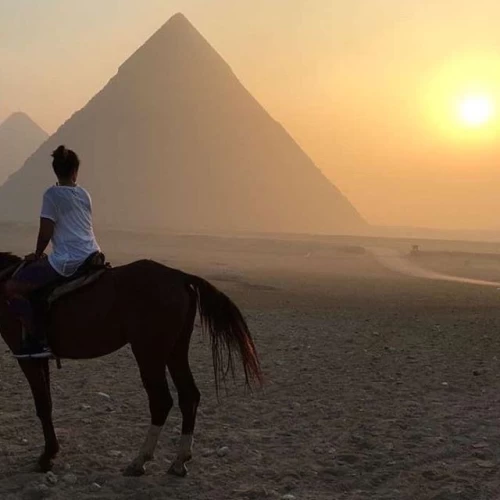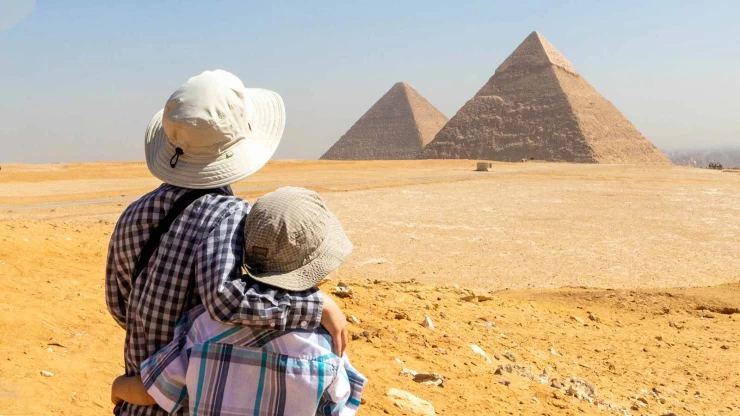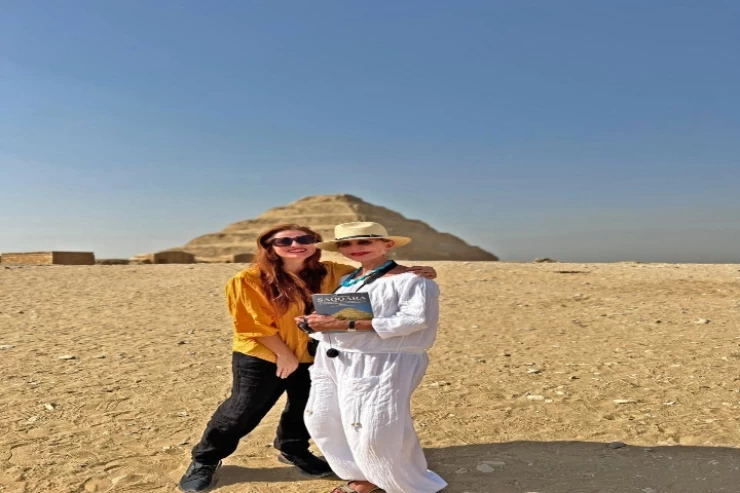
Pyramids of Egypt | Egyptian Pyramids
Djoser's Step Pyramid
It is also the oldest pyramid in Egypt: the age of the construction of the Step Pyramid dates back just to the beginning of the Third Dynasty, during the reign of King Nettrecht (about 2667-2648 BC), under the name already known as Djoser. Later on, this name became commonly used and might be treated nowadays as one of the most known archaeological monuments of Egypt. Therefore, it constitutes an important point in ancient Egyptian history in turning the funerary monuments; for this reason, it represents a revolution in stone architecture, which also brought changes to the field of royal burials. Besides its gigantic size, it is the very first pyramid ever built by ancient Egyptians and the oldest known stone building in the world.
The Leaning Pyramid of Sneferu
It has been enlisted in the UNESCO World Heritage List as part of the Ancient Necropolis of Menf. The original height of the Leaning Pyramid is about 121 meters, with the length of each side at its base about 188.1 meters. It was an angularly inclined pyramid; its first inclination occurs at 55 degrees and 49 meters high, followed by another one after 52 meters at a 43-degree inclination. It includes two entrances: the first one is at the northern side at an altitude of 12 meters, introducing a 79.5-meter-long descending corridor that further leads to a cross hall having a gabled roof and afterward to the irregular corridor from where the right-hand side goes upward towards the west entrance of the pyramid. The left-hand one leads to an unfinished burial chamber; its unfinished roof was made of cedar wood trusses brought from Lebanon. There have been several excavations in the pyramid: the first one was in 1839 A.D. by the British Brange and Fitz when they cleaned the interior of the pyramid, then between 1894 and 1895 A.D. when the De Morgan expedition came. The first scientific expedition has dug up this place.
Red Pyramid
The red pyramid is one of three pyramids built by King Sneferu after the Curved Pyramid, one kilometer south, and the third pyramid called the Pyramid of Meidum. The red pyramid is the tallest of Dahshur pyramids; it is called "Red" due to the tendency of its stones to turn red. It was faced with a layer of white limestone from the quarries of Tura, south of modern Cairo, which was later stripped in the Middle Ages for reuse in building. The Red Pyramid is the third largest Egyptian pyramid after the Khufu and Khafre pyramids in Giza.
Pyramid of Khufu
The Pyramid of Khufu has long been thought of as part of the Seven Wonders of the Ancient World and Great Pyramid constructed from local limestone but when its outer layer has wholly made out of highly valued fine quality of white limestone cladding, that brought Tura quarries by barges. This is a pyramid containing three chambers, one cut in the lower rock, two at a height inside the building itself, as is unique in the pyramid of Cheops and in no other pyramid. This again it is because the visitor can see the sarcophagus in which lay King Khufu since this chamber known as the King's Chamber in the upper chamber is accessible via a corridor with a grand tiered ceiling which is considered to be one of the masterpieces of ancient architecture.
Pyramid of Khafra
The Pyramid of Khafre at Giza is one of the most impressive surviving edifices from ancient times. This pyramid was built in the time of Pharaoh Khafre, about 2520 BC. It is the second largest pyramid inside the Giza complex, though a little short in height compared to the Great Pyramid of Giza, standing to a height of about 136 meters (446 feet) to the top.
Pyramid of Menkaure
The third pyramid in the Giza plateau was constructed by King Menkaure, son of Khafre and grandson of Khufu, who ruled from circa 2532 to 2503 BC. Because it was on a small base area, the original pyramid had attained a height of 65 meters, making Menkaure's pyramid the smallest of the three pyramids of Giza. This small size was due to several factors, including the small area remaining on the Giza Plateau and the materials used for the outer shell of Menkaure's pyramid, as his predecessors used limestone to clad their pyramids, while Menkaure used granite brought from Aswan, more than 800 kilometers away from Giza.
Pyramid of Djedef Ra
The pyramid was not finished. Completed, it would have been the size of the Pyramid of Menkaure-the third largest of the Giza pyramids. This was considered the most beautiful of the pyramids, having an outer surface made of imported polished granite and limestone crowned with a big miniature pyramid. It is also believed that due to its unfinished state, it was largely dismantled during the time of the Roman Empire's rule after conquering Egypt in favor of their buildings.
Information about the Pyramids of Egypt
Egyptian pyramids represent royal tombs developed from the old kingdom to late Ptolemaic, a period amounting to approximately 2700 years. In addition, it neared its construction in the Third Dynasty, up to the Sixth Dynasty-2686 to 2325 BC. Moreover, they are not isolated, but an architectural complex that is composed of the structure.
The ancient Egyptians chose the western side of the Nile to erect pyramids based on their belief that the western side symbolized the world of the dead—the sun sets over there—so they built their graves in the west, while the eastern side represents the world of the living where the sun rises, so they founded their cities there. It was not the sole factor in deciding on the location, but land height was a prerequisite.
Positioned at an elevation surrounded by sand hills, one can easily understand why the pyramids found in Egypt are one of the most recognizable structures quite literally in the whole world. It is perhaps impossible to get a person who has traveled, read, or even watched a documentary and not be captivated by these towering structures that have stood the test of time for centuries. Their beauty and how they were constructed leave no one indifferent and is the primary reason historians, regardless of age, travel to ancient countries. With that being said, let us go back in time to study the greatness of the pyramids in Egypt, why they matter historically, and what impact, if any, they made for future generations.
A Glimpse into Ancient Egypt’s Architectural Genius
From a historical perspective, the magnificence of the pyramids reveals the creativity and architectural skills of the ancient Egyptians. These great edifices, built as shrines for the kings and emperors to symbolize their godly power, display the heightened level of engineering, mathematics, and astronomy acquired by the Egyptians.
These pyramids were not simply built to contain and protect the preserved corpses of kings and queens. They were designed along the lines of doorways or rather turned off to be concerned with the interior, the beyond. The ancients believed that their kings would not only reign over them in this world but also in the next, and so the pyramids were constructed to provide fit accommodations for their wandering spirits. So too with the physical body of the pharaoh, riches, provisions, and ritual items were interred to assist the person’s transition to everlasting life.
The Great Pyramid of Khufu
Due to several centuries of exposure, the pyramid stands at only about 138 m in height, which is still considerable.
The Great Pyramid is estimated to have contained more than 2.3 million stone blocks, with several characters feasible weighing one hundred tons, and considering this, it could be said that the pyramid strategies are among the engineering marvels of the ancient world. Even how the Egyptians would have managed to cut, transport, and assemble the huge blocks remains a mystery—some say that ramps or even cranes had been employed, yet others say that only brute strength sufficed; others propose the use of intellect.
The Pyramid of Khafre
Khafre’s Pyramid, also known as the tomb of Khafre the Son of Pharaoh Khufu, is one of the many structures situated in the Giza plateau region. Even though Khafre's pyramid is shorter than his father's, he seems to dwarf his father’s pyramid because of its placement on higher ground and, more importantly, a large part of the upper part of the pyramid, which has the original smooth casing stones that have survived the weather elements, giving the impression of a much bigger structure. All the pyramids had this layer, made of glossy Tura limestone that was so well polished it was almost glass; hence all of them glittered in the sun.
In addition, the Pyramid of Khafre features the Great Sphinx of Giza, found at the front of the pyramid. The Great Sphinx, which possesses the head of a man and the body of a lion, is carved from a singular piece of limestone and is largely assumed to symbolize Khafre. This giant figure, which is positioned at the front of the pyramids, piques curiosity towards the Giza complex even more.
The Pyramid of Menkaure
Out of the three pyramids in Giza, the smallest is undoubtedly the Pyramid of Menkaure, erected for Khafre’s son, Pharaoh Menkaure. However, this pyramid stands out because part of its casing is made of granite instead of the common limestone used for most well-known pyramids. This material, coupled with the pitch and height of the pyramid, suggests that Menkaure had ambitions of being remembered with the other great kings of Egypt.
Although the Pyramids of Giza are perhaps the most well-known, they are by no means the only pyramids in Egypt. Pyramids were built throughout the Nile Valley at various stages of Egyptian history and in different architectural styles, as well as for different purposes.
The Pyramid of Djoser
The Pyramid of Djoser is considered to be one of the oldest pyramids ever made and can be located in the Saqqara region with its necropolis. This step-designed tomb was built for Pharaoh Djoser by his architect Imhotep, who is mostly regarded as one of the creators of all pyramids to come. Rather than a smooth-sided infinite tower, Djoser’s pyramid is made of six terraced levels with an interesting layered look. This was a great milestone in the age of building pyramids, and it is still one of the most frequent places in Egypt.
The Bent Pyramid and the Red Pyramid
Another well-known location for pyramids is Dahshur, which features the Bent and Red Pyramids, both constructed by Pharaoh Sneferu. The Bent Pyramid stands out due to its unique design since the angles of the sides bend in the middle of the pyramid. This shaped more than a simple pyramid, and it was probably because of some problems encountered while building the pyramid. Nevertheless, it was not much later that Sneferu attempted to build his second pyramid, now called the Red Pyramid, and this one was much more successful than the first, for it became the first true pyramidal structure on a smooth surface within the territory of Egypt.
The massive blocks were maneuvered using ramps, sleds, and some levers. But there are other theories regarding the construction of the great pyramids that are more advanced than this; for instance, aliens coming to earth and building the pyramids, but so-called ‘crazy’ theories are generally not accepted by scholars.
There have been new studies that have come up with such things as the discovery of the workers’ villages and the tools, which also assist in helping people understand the construction of the great pyramids much more than before. Evidence goes against the perception of slavery, for it appears that pyramid builders were given food and shelter, and their work was appreciated.
The geometric understanding of a pyramid, characterized by a wider base that tapers to a point at the top, was designed to represent the rays emitted by the sun as the dead pharaoh was believed to rise and join the sun god, Ra, in death. The position of the pyramids north and south of the equator as well as their alignment with the constellations embodies the Egyptians’ firm belief in the connection between the sky and the land of the living.
Inside the pyramids, spaces, and corridors were typically built with the purpose of housing the pharaoh’s body while also serving as a means to help the spirit cross over. The insides of many pyramids were embellished with inscriptions called Pyramid Texts that consisted of spells for helping the hereafter of the pharaoh. Even though most of the valuables and objects that were kept in these pyramids have been taken away or destroyed over the years, the pyramids themselves are forever embodiments of the Egyptian faith of existence after death.
The Legacy of the Pyramids
The pyramids of Egypt have had a lasting impact on the course of history, in as much as they can be compared to any other structure. The dimensions of the pyramids, their architectural intricacy, together with the enigma surrounding the periods of their construction have motivated several generations of humankind. In the present, those structures attract awe to innumerable people every year who want to see with their own eyes one of the most magnificent monuments created in ancient history.
Besides the appreciation of the pyramids as significant cultural and historical treasures, these structures have also become icons of human determination and creativity. Their position on the skyline of the desert of Egypt evokes memories of a culture that, many millennia ago, was capable of creating marvels that still amaze people today.


















